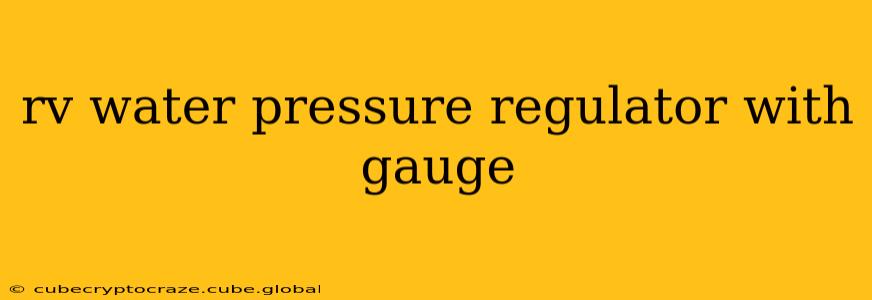Maintaining consistent and safe water pressure is crucial for the enjoyment and longevity of your RV. A water pressure regulator with a gauge is an essential piece of equipment that protects your RV's plumbing system from damage caused by high water pressure at campsites. This comprehensive guide will explore the benefits, features, installation, and maintenance of an RV water pressure regulator with a gauge, answering many frequently asked questions.
Why Use an RV Water Pressure Regulator with a Gauge?
Many campgrounds boast water pressure far exceeding what your RV's plumbing system can safely handle. High water pressure can lead to burst pipes, damaged fittings, and costly repairs. An RV water pressure regulator reduces incoming water pressure to a safe and manageable level, typically around 40-50 PSI (pounds per square inch), protecting your valuable investment. The integrated gauge allows you to monitor the incoming and regulated water pressure, giving you peace of mind and control.
What are the Key Features to Look for in an RV Water Pressure Regulator with a Gauge?
Choosing the right regulator is important. Consider these key features:
- Pressure Adjustment: Ensure the regulator allows you to easily adjust the outgoing pressure to your desired level.
- Gauge Accuracy: A clear, easy-to-read gauge is vital for accurate pressure monitoring. Look for a durable gauge that's resistant to damage.
- Durability and Materials: Opt for a regulator made from high-quality, weather-resistant materials like brass or heavy-duty plastic to ensure longevity.
- Flow Rate: Consider the flow rate – a higher flow rate will ensure sufficient water pressure for multiple appliances simultaneously.
- Easy Installation: A regulator with easy-to-connect fittings will simplify the installation process.
How Do I Install an RV Water Pressure Regulator with a Gauge?
Installation is typically straightforward. However, always consult the manufacturer's instructions for specific details. Generally, the process involves:
- Connecting to the Water Source: Connect one end of the regulator to the campground's water spigot.
- Connecting to the RV: Connect the other end of the regulator to your RV's water inlet.
- Adjusting the Pressure: Use the adjustment knob to set the desired water pressure, usually between 40-50 PSI.
- Monitoring the Gauge: Regularly check the gauge to ensure the pressure remains within the safe range.
How Often Should I Check My RV Water Pressure Regulator?
While infrequent issues are expected, regular checks are a good habit. Before each camping trip, inspect the regulator for any signs of damage or leaks. Also, monitor the gauge during your trip to ensure the pressure remains consistent.
Can I Use a Standard Water Pressure Regulator for My RV?
While standard water pressure regulators might seem suitable, those specifically designed for RVs often incorporate features like higher flow rates and more robust construction, better suited for the demands of RV plumbing. Choosing an RV-specific regulator will provide better protection and performance.
What Happens If My RV Water Pressure Regulator Fails?
A malfunctioning regulator can result in several problems. High water pressure could damage your RV's plumbing system, leading to leaks, burst pipes, and other costly repairs. A faulty regulator could also restrict water flow, leading to low water pressure within your RV.
How Do I Maintain My RV Water Pressure Regulator?
Regular maintenance is key to ensuring your regulator functions correctly and extends its lifespan. Inspect it before each camping trip, ensuring there are no leaks or damage. Occasionally flush the regulator with clean water to remove any sediment buildup.
Where Can I Buy an RV Water Pressure Regulator with a Gauge?
RV water pressure regulators with gauges are widely available at various retailers, including RV supply stores, online marketplaces, and some home improvement centers. Comparing prices and features across multiple sources before buying is recommended.
By understanding the importance of a quality RV water pressure regulator with a gauge and following the tips above, you can protect your RV’s plumbing system and ensure a comfortable and worry-free camping experience. Remember to always prioritize safety and consult with a professional if you encounter any issues during installation or maintenance.
